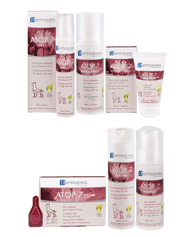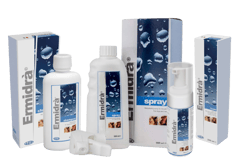
Itchy Skin in Companion Animals
Pruritus (itchy skin) is one of the most common dermatological complaints in veterinary practice, affecting dogs and cats of all breeds and ages. It can significantly impact an animal’s quality of life, leading to excessive scratching, licking, chewing, and secondary skin damage. Identifying the underlying cause of pruritus is essential for effective management and long-term relief.
Common Causes of Itchy Skin
Pruritus in pets can be triggered by a variety of conditions, including:
Allergy
- Atopic dermatitis: A chronic inflammatory skin disease caused by hypersensitivity to environmental allergens (e.g., pollen, dust mites).
- Food allergies: Adverse reactions to specific proteins in the diet, often presenting with persistent pruritus, especially around the face, ears, and paws.
- Flea allergy dermatitis (FAD): A hypersensitivity reaction to flea saliva, causing intense itching, particularly at the tail base and hindquarters.
Parasitic Infestations
- Fleas and mites (Sarcoptes, Demodex, Cheyletiella): Infestations often cause severe pruritus, hair loss, and skin irritation.
- Ticks and lice: Can contribute to localized itching and discomfort.
Infections & Microbial Overgrowth
- Bacterial pyoderma: Often secondary to underlying conditions, bacterial infections can exacerbate itching and lead to pustules and crusting.
- Malassezia dermatitis: Yeast overgrowth commonly found in humid environments, associated with greasy skin and a distinctive odor.
Other Contributing Factors
- Seborrheic disorders: Excessive scaling and oiliness can lead to irritation and secondary infections.
- Endocrine disorders: Hypothyroidism and hyperadrenocorticism can alter skin health, predisposing animals to itching and infections.
- Environmental factors: Dry climates, excessive bathing, and irritants such as harsh shampoos can disrupt the skin barrier.
-

If not treated in time, priritus can lead to wounds, hair loss and serious infections
-

If a pet is scratching excessively it is probably due to some underlying problem
Clinical Signs of Pruritus
- Persistent scratching, licking, or chewing
- Hair loss (alopecia)
- Red, inflamed, or thickened skin
- Hot spots (moist dermatitis)
- Hyperpigmentation and lichenification in chronic cases
- Secondary bacterial or yeast infections
Diagnosis: Identifying the Underlying Cause
A thorough diagnostic approach is critical to differentiate the cause of pruritus and tailor an appropriate treatment plan. Recommended diagnostics include:
- History & Clinical Examination: Assessing onset, frequency, seasonality, diet, and previous treatments.
- Skin Cytology: Identifying bacteria, yeast, or inflammatory cells.
- Skin Scraping & Trichoscopy: Evaluating for ectoparasites (mites, Demodex, Cheyletiella).
- Fungal Cultures & Wood’s Lamp Exam: Detecting dermatophytosis.
- Allergy Testing with PAX serology test
- Dietary Elimination Trials
- Bloodwork & Endocrine Testing: Screening for systemic conditions such as hypothyroidism or Cushing’s disease.
PAX® serum test
...or Pet Allergy Xplorer is the first quantitative multiplex macroarray specifically designed for companion animals that tests for both allergen extracts and molecular components.
Treatment & Management Strategies
A multimodal approach is often necessary to provide relief and prevent recurrence.
- Medicated shampoos, mousses, and sprays help to soothe irritation, restore the skin barrier, and reduce microbial overgrowth. Key benefits include:
- Reducing inflammation and pruritus
- Controlling secondary infections
- Hydrating and strengthening the skin barrier
- Symptomatic medicaton such as corticosteroids, oclacitinib and lokivetmab target pruritus offering immediate relief.
- Essential Fatty Acids (EFAs) that support skin health and reduce inflammation.
- Regular flea control to prevent FAD
- Balanced nutrition, including omega-3 fatty acids
- Moisturizing products to maintain skin hydration
- Allergen-specific immunotherapy (ASIT), the only treatment for the root cause of allergy and that offers long-term relief.
Product selection for pruritus
Managing itchy skin in pets requires a comprehensive approach that not only alleviates pruritus but also addresses the underlying causes and restores skin health. Chronic itching can lead to inflammation, barrier dysfunction, and secondary infections, making it essential to choose the right dermatological support products. Here are the products to keep on hand:
Dermoscent ATOP7®
...is a specialized dermatological range designed for pets with atopic and allergic skin conditions. Dermoscent ATOP7 products contain natural plant extracts and essential fatty acids to hydrate the skin, help reduce inflammation and support the restoration of the skin barrier. Available in shampoo, mousse, and spot-on and more it provides gentle yet effective relief for pruritic pets.
Ermidrà 
...is a line of hydrating products, it includes shampoo, foam and spray, all formulated to soothe dry, itchy, and irritated skin. Ideal for pets with allergic dermatitis or environmental sensitivities, Ermidrà helps restore moisture balance, reducing discomfort and excessive scratching. Its formulation supports skin hydration without leaving a greasy residue, making it a great addition to daily dermatological care.
Dr. Baddaky Omega-3

...offers high-quality omega-3 fatty acids (EPA & DHA) that help reduce skin inflammation, support barrier function, and improve overall health.
Omega-3's play a crucial role in managing chronic pruritus and allergic skin conditions, making them an essential part of multimodal therapy.